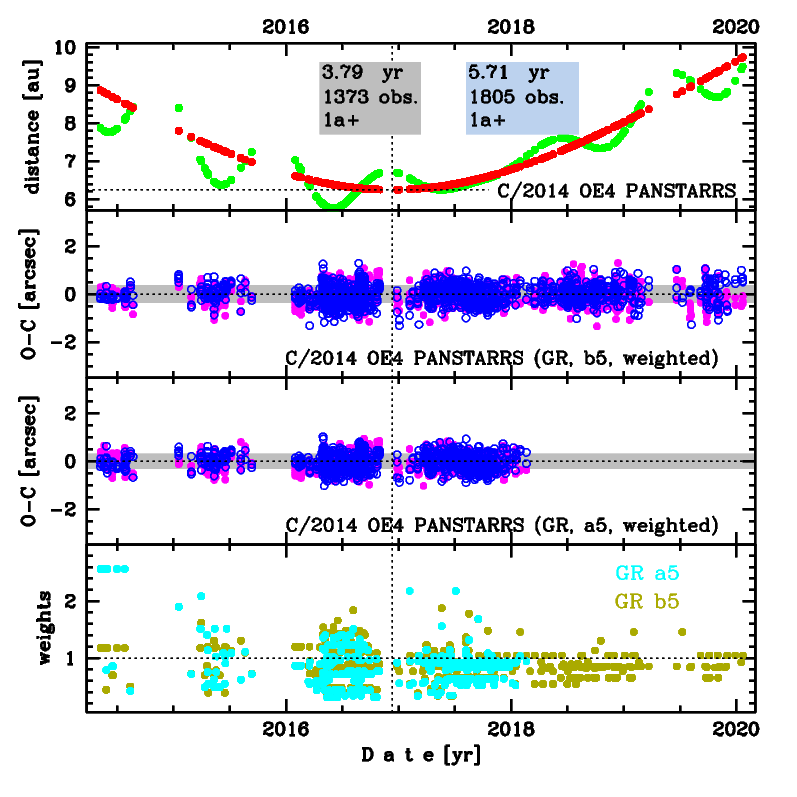C/2014 OE4 PANSTARRS
more info
Comet C/2014 OE4 was discovered on 26 July 2014 with Pan-STARRS 1 telescope (Haleakala), that is 2.4 yr before its perihelion passage; its cometary nature was soon recognised. Next, this comet was found on earlier images taken on several occasion by Pan-STARRS 1, Mount Lemmon Survey and Steward Observatory (Kitt Peak-Spacewatch survey), reaching back to 8 May 2014. This comet was observed until mid-January of 2020.
Comet had its closest approach to the Earth on 1 June 2016 (5.755 au), about six months before its perihelion passage.
Solution given here is based on data spanning over 5.71 yr in a range of heliocentric distances: 8.86 au – 6.253 au (perihelion) – 7.84 au.
This Oort spike comet suffers slight planetary perturbations during its passage through the planetary system; these perturbations lead to a more tight future orbit with a semimajor axis larger than 10,000 au (see future barycentric orbits).
Comet had its closest approach to the Earth on 1 June 2016 (5.755 au), about six months before its perihelion passage.
Solution given here is based on data spanning over 5.71 yr in a range of heliocentric distances: 8.86 au – 6.253 au (perihelion) – 7.84 au.
This Oort spike comet suffers slight planetary perturbations during its passage through the planetary system; these perturbations lead to a more tight future orbit with a semimajor axis larger than 10,000 au (see future barycentric orbits).
| solution description | ||
|---|---|---|
| number of observations | 1373 | |
| data interval | 2014 05 08 – 2018 02 18 | |
| data type | perihelion within the observation arc (FULL) | |
| data arc selection | entire data set (STD) | |
| range of heliocentric distances | 8.86 au – 6.24 au (perihelion) – 6.91 au | |
| detectability of NG effects in the comet's motion | NG effects not determinable | |
| type of model of motion | GR - gravitational orbit | |
| data weighting | YES | |
| number of residuals | 2691 | |
| RMS [arcseconds] | 0.31 | |
| orbit quality class | 1a+ | |
| orbital elements (barycentric ecliptic J2000) | ||
|---|---|---|
| Epoch | 2325 06 02 | |
| perihelion date | 2016 12 09.29723832 | ± 0.00026412 |
| perihelion distance [au] | 6.25313639 | ± 0.00000151 |
| eccentricity | 0.99938998 | ± 0.00000178 |
| argument of perihelion [°] | 65.787985 | ± 0.000026 |
| ascending node [°] | 240.447886 | ± 0.000003 |
| inclination [°] | 81.358584 | ± 0.000004 |
| reciprocal semi-major axis [10-6 au-1] | 97.55 | ± 0.28 |
| file containing 5001 VCs swarm |
|---|
| 2014oea5.bpl |

Upper panel: Time distribution of positional observations with corresponding heliocentric (red curve) and geocentric (green curve) distance at which they were taken. The horizontal dotted line shows the perihelion distance for a given comet whereas vertical dotted line — the moment of perihelion passage.
Middle panel(s): O-C diagram for a given solution (sometimes in comparison to another solution available in CODE), where residuals in right ascension are shown using magenta dots and in declination by blue open circles.
Lowest panel: Relative weights for a given data set(s).
Middle panel(s): O-C diagram for a given solution (sometimes in comparison to another solution available in CODE), where residuals in right ascension are shown using magenta dots and in declination by blue open circles.
Lowest panel: Relative weights for a given data set(s).